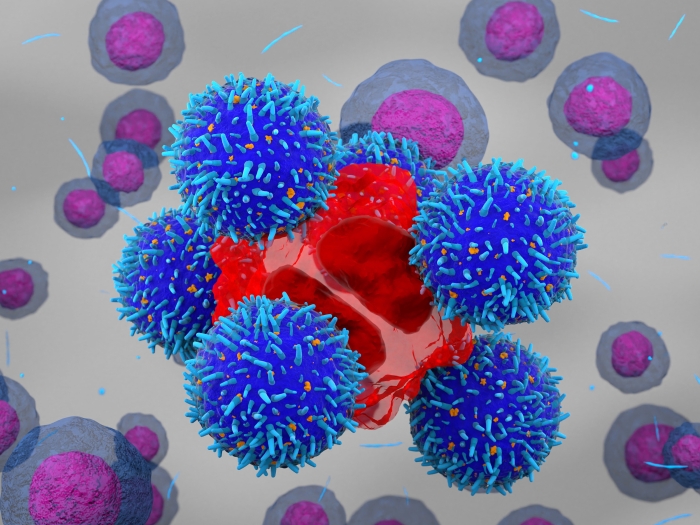The team’s discovery appears to address longstanding mysteries about mutations found in B-cell acute lymphoblastic leukemia
12:32 PM
Author |

Russell Ryan, M.D., an assistant professor in the Department of Pathology at the University of Michigan Medical School and a member of the University of Michigan Health Rogel Cancer Center, and his team used a method called ChIP-Seq to map the regulatory elements that control gene expression in B-cell lymphomas, a cancer of the immune system, in sample B-cell cancer cell lines.
By analyzing the sequences found in B-cell lymphomas, Ryan’s team hoped to deduce the identity of proteins called transcription factors that play key roles in activating cancer-causing genes. For comparison, they included a set of samples from B-cell acute lymphoblastic leukemia, or B-ALL, a pediatric blood cancer that the group had not previously studied.
They were surprised to find that active regulatory elements in B-ALL contained not only typical protein binding sequences but also simple repeats of the sequence “GGAA,” usually considered a form of so-called junk DNA with no regulatory function.
“Many investigators ignore repeat elements in this sort of analysis,” said Ryan. “My bioinformatician decided not to filter them out, and it led us in a whole new direction.”
Ryan’s team soon realized that these “repeat enhancers” were consistently active in a subtype of B-ALL called ETV6-RUNX1+ B-ALL, the second most common pediatric cancer in the United States, representing 25% of pediatric B-ALL cases.
Although the defining oncogene (a gene that can turn a cell cancerous) of this type of leukemia, ETV6-RUNX1, itself encodes a transcription factor, Ryan’s team found that the ETV6-RUNX1 protein wasn’t directly activating the repeat enhancers.
Instead, they found that the transcriptional repressor ETV6 normally binds to and silences these repeats. When the ETV6 gene is “broken” by the formation of the ETV6-RUNX1 fusion, an activating protein called ERG replaces ETV6 at the repeats and converts them to active enhancers.
By restoring ETV6 to the leukemia cells, Ryan’s team was able to shut down these repeat enhancers and identify the genes they activate, demonstrating that repeat enhancers control a known gene expression signature of ETV6-RUNX1+ B-ALL.
One repeat enhancer activated the EPOR gene, whose expression is normally exclusive to red blood cells, allows leukemia cells to respond to the growth-promoting blood hormone erythropoietin.
Ryan’s discovery suggests an explanation for why many ETV6-RUNX1+ leukemias gain additional mutations that destroy the second copy of the ETV6 gene. It also indicates why leukemias with other ETV6-disrupting mutations can often mimic the gene expression program of ETV6-RUNX1+ B-ALL.
While genes and normal regulatory elements are often well-conserved between humans and mice, junk DNA sequences like GGAA repeats are usually very different and may not have the same effects in mice as they do in human leukemia. This discovery may explain why scientists have found it to be so difficult to re-create ETV6-RUNX1+ B-ALL in mouse models.
Additional authors include Rohan Kodgule, Joshua W. Goldman, Alexander C. Monovich, Travis Saari, Athalee R. Aguilar, Cody N. Hall, Nihanka Rajesh, Juhi Gupta, Shi-Chun A. Chu, Li Ye, Ashwarya Gurumunthy, Ashwin Iyer, Noah A. Brown, Mark Y. Chang and Marcin P. Cieslik
Paper cited: “ETV6 Deficiency Unlocks ERG-Dependent Microsatellite Enhancers to Drive Aberrant Gene Activation in B-Lymphoblastic Leukemia,” Blood Cancer Discovery. DOI: 10.1158/2643-3230.BCD-21-0224
Live your healthiest life: Get tips from top experts weekly.
Headlines from the frontlines: The power of scientific discovery harnessed and delivered to your inbox every week.
Like Podcasts? Add the Michigan Medicine News Break on Spotify, Apple Podcasts or anywhere you listen to podcasts.

Explore a variety of health care news & stories by visiting the Health Lab home page for more articles.

Department of Communication at Michigan Medicine
Want top health & research news weekly? Sign up for Health Lab’s newsletters today!





